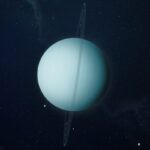We explain what Neptune is, its location in the solar system and its dimensions. Also, what are its characteristics, its climate and geological composition.
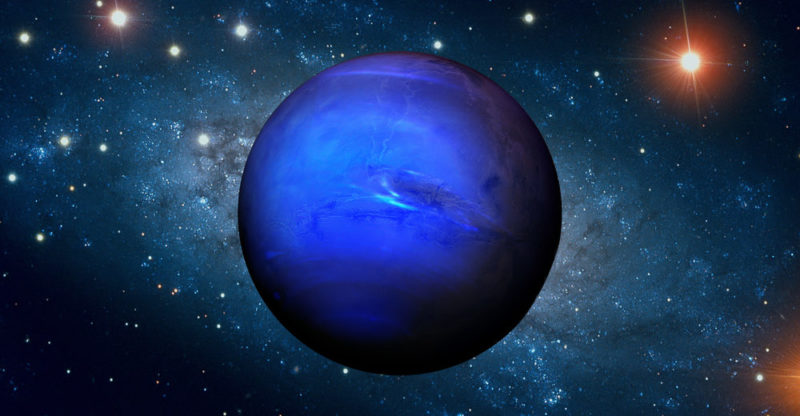
What is Neptune?
Neptune is a planet in the solar system, the furthest from the Sun and the smallest of the four gas giants. It was observed for the first time in 1846 and is made up of a mixture of water, ammonia and methane on a solid rocky center. Its atmosphere is mainly composed of hydrogen, helium and methane. The high concentration of methane gives it its blue appearance, since this gas absorbs red light and reflects blue light.
Due to its distance from the Sun, it is one of the coldest planets in the entire solar system. Its average temperature is -218 °C. Its rotation time is very short, only 16 hours. On the contrary, its translation period is very slow: it takes 165 years to complete one revolution around the Sun.
The name Neptune comes from the Roman god of the sea. It was proposed by the German astronomer Johann Galle (1812-1910), one of the first to observe the planet shortly after its discovery in 1846. It is believed that he decided on this name because of Neptune’s bluish appearance.
Characteristics of Neptune
The main characteristics of Neptune are:
- It has a diameter of 49,244 kilometers.
- It is the planet furthest from the Sun.
- It has an average temperature of -218 °C.
- Its rotation time lasts 16 hours.
- Its translation period is 165 years.
- It was discovered in 1846.
- It has fourteen moons.
- It has winds that exceed 1,900 kilometers per hour.
- The Voyager 2 probe first observed it in 1989.
Until the discovery of Pluto in 1930, it was considered the planet furthest from the Sun in the entire solar system. In 2006 it was again, since Pluto was no longer considered a planet.
Structure of Neptune

Neptune’s internal structure is similar to that of its neighboring planet, Uranus. It has a rocky core covered by a frozen mantle, which is in turn under a thick and thick atmosphere:
- Core Neptune’s core is composed of iron, nickel and silicates with a mass greater than the core of planet Earth. The pressure at the center of the core is approximately double that at the center of our planet.
- Mantle Neptune’s mantle is equivalent to about 15 times the mass of our planet and is a vast ocean of water, ammonia and methane. A very curious characteristic of this mantle is that at a depth of 7000 kilometers the methane decomposes into diamond crystals that rain towards the solid core like a kind of hail. Neptune is a planet where it literally rains diamonds.
- Atmosphere Neptune’s atmosphere is made up of hydrocarbon gases such as methane, ethane and acetylene. It is subdivided into two main regions: the lower region (troposphere), where temperature decreases with altitude, and the upper region (stratosphere), where temperature increases with altitude.
Neptune Climate
Neptune’s climate It is characterized by average temperatures of -353º F (-214º C) and enormous storms with winds up to eight times stronger than the most powerful hurricane ever recorded on our planet.
These supersonic winds can reach 2,000 kilometers per hour, equivalent to the maximum speed of the F/A-18 Hornet, one of the fastest fighters in the North American Air Force.
Neptune is so far away receives a thousand times less sunlight than Earth. It is still a mystery how Neptune obtains the energy for such intensity of weather, although it is believed to be due to the planet’s great internal heat (Neptune radiates 2.61 times more energy than it receives from the Sun).
Location and dimensions of Neptune
Neptune is 4.5 billion kilometers away from the Sun and 4.3 billion kilometers from Earth.. Its orbit is located behind that of Uranus, beyond the Asteroid Belt that divides the solar system.
Regarding its dimensions, Neptune has a mass 17 times greater than that of Earth and a volume equivalent to 57 times our planet. It has a diameter of 49,572 kilometers. This makes it the fourth largest planet in diameter and the third largest mass in the entire solar system.
Due to its gaseous composition, its rotation time is difficult to calculate. It is believed that it takes 16 hours to make one revolution on its own axis and 165 years to complete its orbit around the Sun.
Geology of Neptune
Neptune’s atmosphere, that is, the gaseous layer that surrounds the planet, contains hydrogen, helium, methane, ammonia and other compounds. Towards the planet’s interior, pressure and temperature conditions cause gases to be compressed into liquids and a solid core in the center.
The liquids that make up the interior of Neptune are mainly water, ammonia and methane in a liquid state. The solid core in the center is composed mostly of rocks and metals.
Neptune’s atmosphere
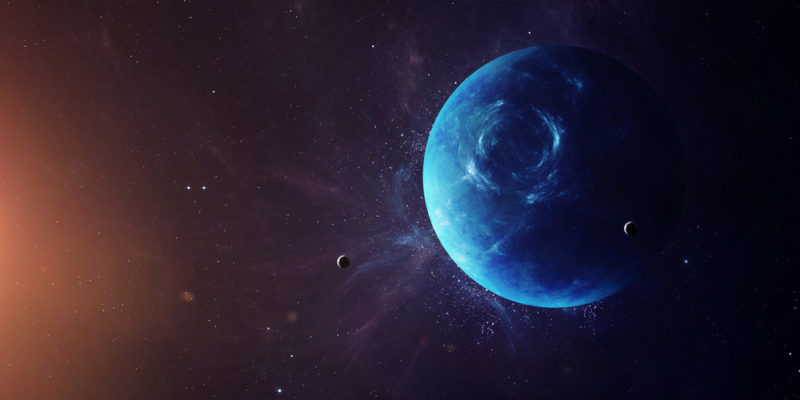
The main gases that make up Neptune’s atmosphere are hydrogen, helium, methane, ammonia and water vapor. Its characteristic blue tone is mainly due to the presence of methane, which absorbs red light and reflects blue light. Neptune’s upper atmosphere is exceptionally cold, with temperatures dropping to -218°C.
In addition, The winds on Neptune are notoriously strong and reach speeds of over 1,900 kilometers per hour the strongest observed in the solar system. These powerful winds give rise to the presence of large storms, such as the Great Dark Spot, one of the most notable phenomena observed by the Voyager 2 probe.
Satellites and rings of Neptune
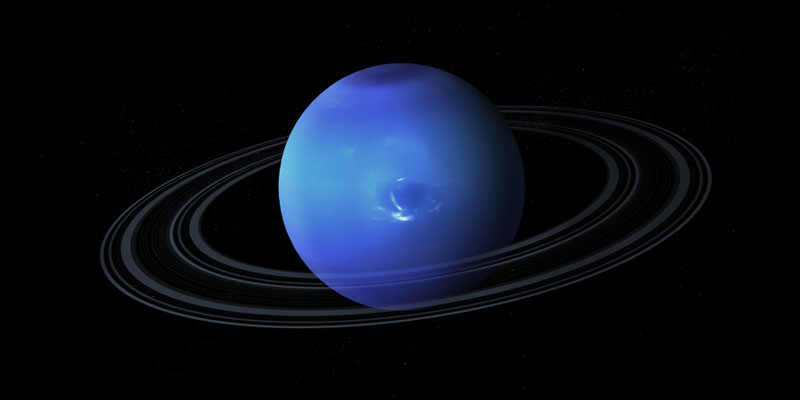
Neptune has a system of five rings and fourteen moons that are part of its planetary system.
- Moons. Triton is the largest moon of Neptune and one of the largest moons in the solar system. It has a surface of rocks and ice, and geysers that expel nitrogen and other substances from its surface. Neptune also has several smaller moons that orbit near the planet, such as Proteus and Nereid.
- Rings. Neptune has rings that are difficult to observe from Earth due to their dim luminosity. They were discovered by the Voyager 2 probe in 1989. They are composed mainly of ice and dust particles. The Adams rings, 63,000 kilometers from the center of Neptune, Le Verrier, 53,000, and Galle, 42,000, are the three most important on the planet.
Discovery of Neptune

The theoretical prediction of where Neptune would be in the sky was made by two astronomers, Urbain Le Verrier in France and John Couch Adams in England. Both used mathematical calculations carried out by Alexis Bouvard, based on the irregularities observed in the orbit of Uranus, to predict the existence of a new planet.
With these calculations, Johann Gottfried Galle and Heinrich d’Arrest carried out the search for the planet. On September 23, 1846, Galle and D’Arrest used the coordinates provided by Le Verrier to find Neptune with a telescope.
Observation and exploration of Neptune
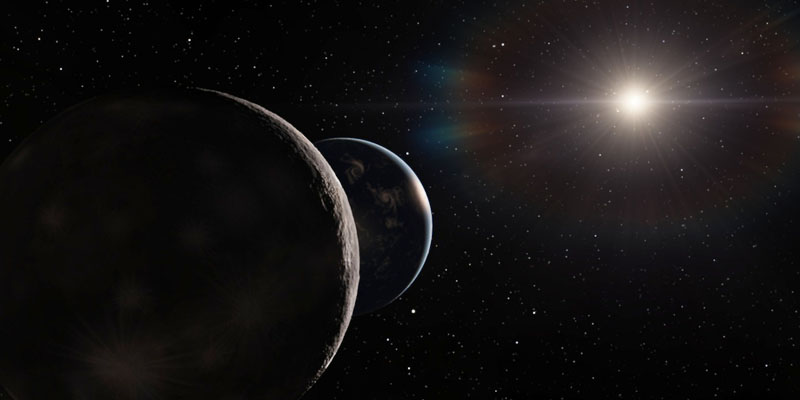
In the mid-19th century, astronomers observed irregularities in the orbit of Uranus that could not be fully explained by the known laws of gravity. Being the planet furthest from the Sun (the only source of light in the solar system), its observation from Earth is very complex due to its low luminosity.
Direct exploration of Neptune occurred only toward the end of the 20th century, when the Voyager 2 space probe arrived close to its orbit in 1989. Voyager 2 provided detailed data about Neptune’s atmosphere, rings, and moons, as well as valuable information about its magnetic and atmospheric characteristics.
References
- Graziati, G. (2023). Neptune rings: how many does it have and names. EcologyGreen. https://www.ecologiaverde.com/
- Milo, A. (2023). This is Neptune, the farthest and darkest planet in the Solar System. National Geographic in Spanish. https://www.ngenespanol.com/
- NASA Science. (2021). All about Neptune. https://spaceplace.nasa.gov/


